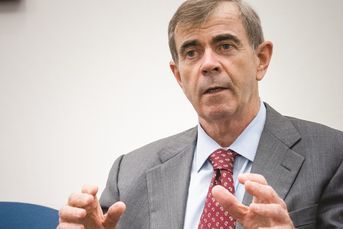RIAs are losing their competitive advantage
Simply playing the fiduciary card to win over investors may not work the way it did in the past.
Registered investment advisers need a new card up their sleeve.
For years, RIAs have marketed themselves as being a cut above their counterparts in the brokerage industry. While they followed a fiduciary standard, requiring them to act in their clients’ best interests at all times, brokers were merely required to make sure their advice was suitable to the financial circumstances of their clients.
Now the world is changing. Thanks to the Labor Department’s fiduciary rule, everyone giving retirement advice will be required to act in their clients’ best interests. Put another way, RIAs are losing their competitive advantage. Simply playing the fiduciary card to win over investors may not work the way it did in the past.
Big brokerage firms already are shifting toward a more RIA-like, fee-based compensation model in place of their old commission-based one. And despite two lawsuits filed last week to strike down the new regulation — one by a group including the Securities Industry and Financial Markets Association — it’s still on the books, and firms must be ready to comply as soon as next year.
“You’re going to see a lot of people move toward a fee-based model,” said Peter Mallouk, president and chief investment officer for Creative Planning, an RIA based in Leawood, Kan.
Brokerages also are offering more goals-based financial planning similar to the services delivered by RIAs, a move that is seen working well within the new regulatory framework laid out by the DOL.
As a result, RIAs will need to come up with a counterstrategy and develop a stronger pitch than “we’re fiduciaries and they’re not” to attract and retain clients.
The regulation makes it “harder for an RIA to use this as part of the value proposition,” Mr. Mallouk acknowledged.
WINNING STREAK
For the past several years, RIAs have been on a clear winning streak. They were the fastest growing part of the $19.2 trillion wealth management industry for a fourth straight year in 2015, increasing client assets 4.5% to $2.8 trillion, according to research and consulting firm Aite Group. They’ve more than doubled assets since the end of 2007 and now oversee almost 15% of the industry’s total. Meanwhile, the wirehouses saw clients’ assets shrink 1.8% last year to about $6.4 trillion, the Aite Group estimated in a report last month.
While the DOL rule applies to advisers only when they are giving retirement advice, there’s a lot at stake. Individual retirement accounts totaled $7.3 trillion of assets at the end of last year, while 401(k) plans held $4.7 trillion, according to the Investment Company Institute.
And there are signs that the fiduciary standard could be spreading beyond the retirement advice market. Under the 2010 Dodd-Frank financial reform law, the Securities and Exchange Commission has the authority to impose a uniform fiduciary standard for all types of financial advice. SEC Chairwoman Mary Jo White has said she is in favor of the idea, and the agency has it listed on its agenda for next spring.
One way RIAs are reacting to the loss of their competitive advantage is through mergers. Some in the industry believe it might help them gain economies of scale and compete more efficiently for assets.
RECORD MERGER ACTIVITY
The RIA sector saw record merger activity last year as megadeals involving more than $5 billion of assets surged, according to consulting firm DeVoe & Co.
The pace of deal making slowed slightly during the first three months of this year, but remained strong as sales of firms with $1 billion to $5 billion of assets soared, a May research report from DeVoe showed.
“It’s a marketplace where differentiating yourself has become more challenging than it has been historically,” said David DeVoe, the firm’s founder. “RIAs are seeking to gain scale and additional capabilities through mergers that will enable them to better compete.”
Bronfman E.L. Rothschild, a Rockville, Md.-based RIA with about $4 billion of assets, is currently considering potential acquisitions to boost business with ultra-high-net-worth clients who have at least $20 million to invest, according to its chief executive, Neal Simon.
“We’re looking at a big deal in New York,” he said, which could increase assets to about $5 billion.
Bronfman E.L. Rothschild, whose average client has about $4 million, wants to increase its assets to about $10 billion in the next four years, according to Mr. Simon.
For all the debate and disruption the Labor Department’s new regulation has created in the financial advice industry, most consumers aren’t aware of it, said Scott Hanson, co-founder of Hanson McClain Advisors, an independent advisory firm based in Sacramento, Calif.
For that reason, he said he doesn’t see the competitive landscape changing all that quickly.
Mr. Simon doesn’t expect the fiduciary rule to have that much of an impact on his business, and he said there still will be a number of differences between brokerages and RIAs. Despite the move toward a fee model at some of the big brokerages, many still focus on investment products and hand out bonuses and other incentives for hitting sales targets, he said.
“I bonus people on client retention,” Mr. Simon said. “It’s just a different mentality.”
The thousands of independent RIAs across the U.S. oversee less than half the combined assets at the four wirehouses: Bank of America Merrill Lynch, Morgan Stanley, Wells Fargo Advisors and UBS Wealth Management Americas. But the RIAs’ pool of assets last year was 15% larger than the fee-based portion overseen by the wirehouses, according to the Aite Group.
At the end of the day, Mr. Mallouk of Creative Planning said the fiduciary rule will test everyone in the financial advice business.
“The better firms will end up stronger,” he said.
Learn more about reprints and licensing for this article.






